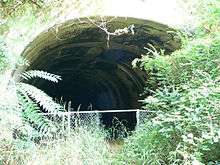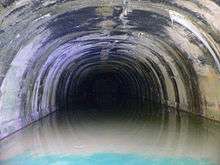Church Hill Tunnel
|
The sealed western entrance to the Church hill Tunnel | |
| Overview | |
|---|---|
| Line | Chesapeake and Ohio Railway (C&O) |
| Location | Richmond, Virginia |
| Coordinates | Coordinates: 37°31′37″N 77°24′52″W / 37.52694°N 77.41444°W |
| Status | Unsafe, sealed |
| Operation | |
| Opened | 1875 |
| Closed | 1925 |
| Owner | CSX Transportation |
| Technical | |
| Line length | 4,000 feet |
| No. of tracks | none at present |
| Track gauge | 1,435 mm (4 ft 8 1⁄2 in) |
Church Hill Tunnel is an old Chesapeake and Ohio Railway (C&O) tunnel, built in the early 1870s, which extends approximately 4,000 feet under the Church Hill section of Richmond, Virginia. In 1925, the tunnel collapsed on a work train, killing four and trapping a steam locomotive and some flat cars. Rescue efforts only resulted in further collapse, and the tunnel was eventually sealed for safety reasons.
Portions of the tunnel have continued to wreak havoc above in the years since, and several houses and a wall of a church were destroyed near 25th and Broad Streets. More recently, tennis courts and the wall of a house seem to have been victims farther east. Long the subject of community speculation and trespassing incidents at its eastern end, the tunnel is owned by CSX Transportation. The tunnel, which is still considered dangerous, was featured in a 1998 newspaper article by Richmond Times-Dispatch reporter Mark Holmberg, who explored portions from the eastern end with professional caving personnel and equipment.[1]
History
Purpose
The Church Hill Tunnel was completed in 1875 for the Chesapeake and Ohio Railway (C&O) which was seeking to extend its trackage (of the former Virginia Central Railroad) from a terminus in the Shockhoe Valley section of downtown Richmond to connect with the new Peninsula Subdivision extending approximately 75 miles southeast down the Virginia Peninsula to reach Collis P. Huntington's new coal pier at Newport News on the harbor of Hampton Roads.[2] The tracks to the new tunnel left the old Virginia Central line west of 17th street and curved southeasterly to enter the tunnel east of N. 18th Street and north of E. Marshall Street under Cedar Street.[3] The east end of the tunnel appeared just north of Williamsburg Road near 31st Street below Libby Terrace Park. The Peninsula railroad line was completed and opened in late 1881, and the coal flowed eastward for export in massive quantities.
Construction problems
The construction of the tunnel was problematic. Unlike the bedrock through which the C&O carved its western tunnels, in Richmond, the blue marl clay shrink-swell soil tended to change with rainfall and groundwater and there were cave-ins during the construction. Ten workers were reportedly killed. The tunnel has remained troublesome throughout its life due to ground water seepage and safety concerns, even after abandonment in 1925.
Safer alternative
In the 1890s, the C&O acquired the Richmond and Allegheny Railroad (R&A) which had been built east from the Blue Ridge Mountains along the towpath of the James River and Kanawha Canal, proving an alternate "water level" route to Richmond following the north bank of the James River and avoiding a more circuitous route which crossed the North Mountain and Afton Mountain via the Blue Ridge Tunnel and reached Richmond via the former Virginia Central Railroad. However, the R&A terminated at Richmond's Byrd Street Station in the downtown area (7th St. and Canal St.), and did not have a track connection to the C&O which ended at Shockoe Bottom at Broad Street, some distance away. The Virginia State Capitol (and Capitol Hill) was directly between the two terminals, so creativity for a less direct connection was needed.
To utilize the new "water level" line to ship coal to Newport News, and as an added benefit, avoid the troublesome tunnel, the C&O constructed a 3-mile-long double track elevated viaduct along the riverfront extending between the area of Hollywood Cemetery east past downtown Richmond, the Shockoe Valley, and Church Hill to join the Peninsula Subdivision at what became Fulton Yard east of the tunnel. With a connection just south of the new Main Street Station, it was now possible for traffic to come off the old Virginia Central and enter the Peninsula Subdivision without using the Church Hill Tunnel. Portions of the viaduct became known as the Rivanna Subdivision Trestle (west of Rivanna Junction) and Peninsula Subdivision Trestle (from the former Brown Street Yard through Main Street Station and Rivanna Junxction east to Fulton Yard). The viaduct is believed to be the longest in the United States and is still in use by CSX Corporation, which also owns the abandoned tunnel.[3])The viaduct is also the highest level of Richmond's famed Triple Crossing, with railroads at three levels, believed to be the only such place in the world, near where it crosses Richmond's James River Flood Wall.
Tunnel disuse, rehabilitation turns tragic
After completion of the riverfront viaduct in 1901, the Church Hill Tunnel fell into disuse for over 20 years. Then in 1925, to add capacity, the railroad began efforts to restore it to usable condition.[2] On October 2, while repairs were under way, a work train was trapped by a collapse near the western end. Two workmen crawled under flat cars and escaped out the eastern end of the tunnel, as did the fireman Benjamin F. Mosby (who died hours later because of the burns caused by the ruptured boiler),[4] but the engineer Thomas Joseph Mason was killed and two other workers were unaccounted for.[5]
During the next week, the community anxiously watched rescue efforts, but each time progress was made, further cave-ins occurred; only the body of the engineer was recovered on October 10.[6] Possibly two workers were missing.[7]Eventually, the Virginia State Corporation Commission (SCC) which regulated railroads in Virginia ordered the tunnel sealed for safety reasons.[5] Left inside was the work train complete with a 4-4-0 steam locomotive[8] (engine #231) and 10 flat cars.
Later years


Over the years, portions of the tunnel have collapsed, once claiming several houses. The line of the underground tunnel can clearly be traced by dips in some of the north-south streets crossing its path. The largest cave-in to date resulted in creation of a park on Broad Street between 24th and 25th where a church once stood.[9]
The western end is covered with a concrete plug, but for years, the eastern end was used as part of a turning wye for a connection with the Southern Railway's line to West Point and could be entered by venturesome trespassers. Based upon a 1998 exploratory expedition by Richmond Times-Dispatch reporter Mark Holmberg, who explored portions from the eastern end with professional caving personnel and equipment, it is believed that most of the western portion of the tunnel which has not caved in is filled with water.[2] The western end entrance of the collapsed tunnel can still be seen at the south-east end of an alley off of 18th Street, just north of Marshall. A Virginia historical marker was placed at the site in 2012. The eastern end is hidden in a small, dense jungle just north of the intersection of E. Franklin Street and N. 31st Street. This end of the tunnel is still open for some distance, but its floor and the area outside are swampy.
Recovery discussions
In June 2006, the Virginia Historical Society and other parties announced that they were investigating the possibility of recovering the train and bodies; the Society planned to keep the train for preservation. The History Channel expressed interest in participating in the project. However, when a hole was drilled through the tunnel's seal and a camera was placed inside, the tunnel was discovered to be filled with silt and water, meaning that an excavation of the tunnel would likely cause it to further collapse and cause several homes on Church Hill to be engulfed by massive sinkholes. The project was put on hold.
Urban legend
The Church Hill Tunnel also has a connection to the urban legend of the Richmond Vampire.
References
- ↑ Holmberg, Mark (5 July 1998). "Crawling Into the Belly of a Richmond Legend". Richmond Times-Dispatch. pp. A1.
- 1 2 3 "Church Hill Tunnell". VT Underground. Retrieved 2006-06-27.
- 1 2 Daily, Larry Z. (1997). "Richmond". C&O Piedmont Subdivision Homepage. Retrieved 2006-06-27.
- ↑ Find a grave memorial
- 1 2 "The Train in the Tunnel". Newspaper Clipping Files; Literature and History Department; Main Library. Richmond Public Library. Archived from the original on 2006-02-20. Retrieved 2006-06-27.
- ↑ Find a grave memorial
- ↑ Church Hill Tunnel
- ↑ "Surviving Steam Locomotives in Virginia". Surviving Steam Locomotives. SteamLocomotive.com. 2006-06-21. Retrieved 2006-06-27.
- ↑ Mensah, Akida; Mary Ellen Bushey (1982-09-01). "Transcript of Interview with Mr Aubrey Ramsey, September 1, 1982.". Virginia Black History Archives, Church Hill Oral History Collection. Virginia Commonwealth University Libraries. Retrieved 2006-06-27.
External links
- Richmond Public Library newspaper archives
- Richmond Then and Now website
- National Railway Historical Society